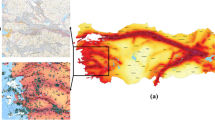Abstract
Major part of the structural stock in Turkey doesn’t have sufficient endurance, rigidity and ductility against possible large earthquakes. Strengthening of structures against earthquakes always appears on the agenda and structures are being strengthened by using different techniques. In this context, cast in place reinforced concrete shear walls is a highly effective and reliable method for improving the system behavior. However, construction work takes long time in this method, so the structure is required to be emptied before the practice. For this reason, it is required to develop the strengthening methods which facilitates lives of people and which is economic and effective in terms of structure. The principle of the technique recommended in this study is to convert plastered hollow brick walls of the structure to shear walls equivalent to reinforced concretes (RC) by strengthening them with high-strength precast new diagonal concrete panels. For this purpose, a reinforced concrete frame, which is 1/3 scaled, low-strengthened against earthquake, has two-story and single span unreinforced brick infilling wall, has been produced with failures frequently seen especially in concrete buildings of our country as reference sample. Moreover, strengthening three reinforced concrete infilled frame wall having same features with reference sample by new diagonal concrete panels which are precast, high strengths in different shapes used for the first time in the literature, their behaviors under reversible-repeatable horizontal loading simulating earthquake effect have been tested. Results of the experiment have been compared with the analytic study and it has been observed that applied technique has increased the energy dissipation capacity of test elements and improved the earthquake behaviors.
Similar content being viewed by others

References
Acun, B. and Sucuoglu, H. (2005). “Modeling technics of infill walls in reinforced concrete frames under the effects of earthquake.” Earthquake Symposium, Kocaeli, pp. 965–971, Turkey, 23-25 March.
Akin, A. (2011). Experimental and analytical study on the seismic behavior of the infill reinforced concrete frames with precast reinforced concrete panels, PhD Thesis, Selcuk University, Konya, Turkey.
Akin, A. and Sezer, R. (2016). “A study on strengthening of reinforced concrete frames using precast concrete panels.” KSCE Journal of Civil Engineering, KSCE, pp. 1–8. DOI: 10.1007/s12205-016-0188-z.
Baran, M. (2005). Precast concrete panel reinforced infill walls for seismic strengthening of reinforced concrete framed structures, PhD Thesis, Middle East Technical University, Ankara, Turkey.
Baran, M., Canbay, E., and Tankut, T. (2010). “Seismic strengthening with precast panels -theoretical approach.” Digest, December, pp. 1403–1423.
Baran, M. and Tankut, T. (2011). “Retrofit of Non-Ductile RC frames with Precast Concrete (PC) WallPanels.” Advances in Structural Engineering, Vol. 14, No. 6, pp. 1149–1166, DOI: 10.1260/1369-4332.14.6.1149.
Baran, M. and Tankut, T. (2011). “Experimental study on seismic strengthening of reinforced concrete frames by precast concrete panels.” ACI Structural Journal, Vol. 108, No. 2, pp. 227–237.
Binici, B., Ozcebe, G., and Ozcelik, R. (2007). “Analysis and design of FRP composites for seismic retrofit of infill walls in reinforced concrete frames.” Composites: Part B, Vol. 38, pp. 575–583, DOI: 10.1016/j.compositesb.2006.08.007.
CSI (0000). SAP2000 v.17.3, “Integrated Finite Element Analysis and Design of Structures Basic Analysis Reference Manual”, Computers and Structures, Inc., Berkeley, California, USA.
El-Dakhakhni, W. W., Hamid, A. A., Hakam, Z. H. R., and Elgaaly, M. (2006). “Hazard mitigation and strengthening of unreinforced masonry walls using composites.” Composite Structures, Vol. 73, pp. 458–477, DOI: 10.1016/j.compstruct.2005.02.017.
ElGawady, M., Lestuzzi, P., and Badoux, M. (2004). “A review of conventional seismic retrofitting techniques for URM.” 13th International Brick and Block Masonry Conference, Amsterdam, 1–9, June.
Ersoy, U. and Uzsoy, S. (1971). The Behavior and Strength of Infilled Frames, Tübitak Proje No. MAG-205 (in Turkish), Ankara, Turkey.
Farooq, S. H., Ilyasb, M., and Ghaffarb, A. (2006). “Technique for strengthening of masonry wall panels using steel strips.” Asian Journal of Civil Engineering (Building and Housing), Vol. 7, N. 6, pp. 621–638.
Frosch, R. J, Wanzhi, L., Jirsa, J. O., and Kreger, M. E. (1996). “Retrofit of non-ductile moment-resisting frames using precast infill wall panels.” Earthquake Spectra, Vol. 12, No. 4, pp. 741–760, November.
Hanoglu, K. B. (2002). “Fiber reinforced plastic overlay retfofit of hollow clay tile masonry infilled reinforced concrate frames.” Bogaziçi University, PhD Thesis. Istanbul, Turkey.
Kesner, K. and Billington, S. L. (2005). “Investigation of infill panels made from engineered cementitios composites for seismic strengthening and retrofit.” ASCE Journal of Structural Engineering, Vol. 131 No. 11, pp. 1712–1720, DOI: 10.1061/(ASCE)0733-9445(2005)131:11(1712).
Perera, R., Gomez, S., and Alarcon, E. (2004). “Experimental and analytical study of masonry infill reinforced concrete frames retrofitted with steel braces.” ASCE Journal of Structural Engineering, Vol. 130 No. 129, DOI: 10.1061/(ASCE)0733-9445(2004)130:12 (2032).
Reinhorn, A.M. (1997). “Inelastic Analysis Tecniques in Seismic Evaluations.” Proceedings of the International Workshop on Seismic Design Methodologies for the Next Generation of Codes, pp. 277–287. Slovenia.
Sevil, T., Baran M., Bilir, T., Canbay, E. (2011). “Use of steel fiber reinforced mortar for seismic strengthening.” Construction and Building Materials, Vol. 25, pp. 892–899, DOI: 10.1016/j.conbuildmat. 2010.06.096.
Sonuvar, M. O., Ozcebe, G., and Ersoy, U. (2004). “Rehabilitation of reinforced concrete frames with reinforced concrete infills.” ACI Structural Journal, Vol. 101, No. 4, pp. 494–500.
TEC-07 (2007). Turkish earthquake code, regulations on structures constructed in disaster regions, The Ministry of Public Works and Settlement. Ankara.
Triantafillou, T. C. (1998). “Strengthening of masonry structures using epoxy bonded FRP laminates.” ASCE Journal of Compos Constr, Vol. 2, No. 2, 96–104, DOI: 10.1061/(ASCE)1090-0268(1998)2:2(96).
Zhang, Y. and Wang, Z. (2000). “Seismic Behavior of reinforced concrete shear walls subjected to high axial loading.” ACI Structural Journal, Vol. 97, No. S275, pp. 739–750.
Author information
Authors and Affiliations
Corresponding author
Rights and permissions
About this article
Cite this article
Aksoylu, C., Sezer, R. Investigation of precast new diagonal concrete panels in strengthened the infilled reinforced concrete frames. KSCE J Civ Eng 22, 236–246 (2018). https://doi.org/10.1007/s12205-017-1290-6
Received:
Revised:
Accepted:
Published:
Issue Date:
DOI: https://doi.org/10.1007/s12205-017-1290-6



